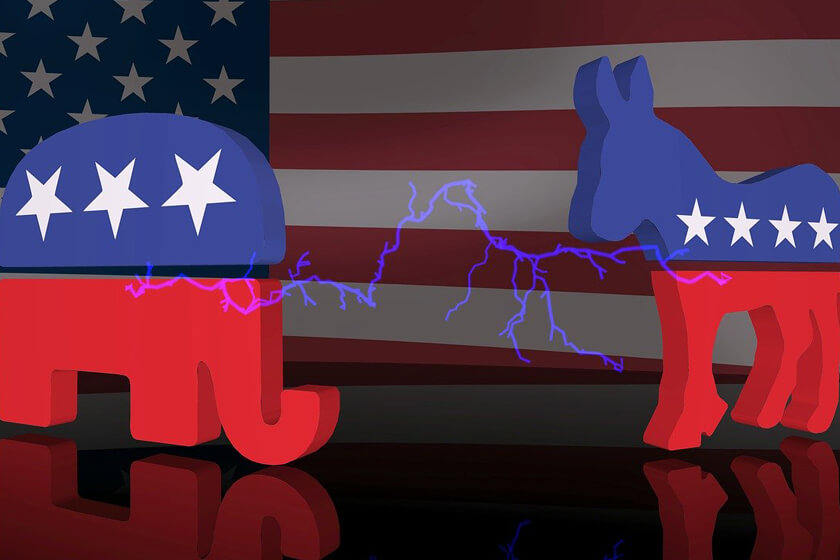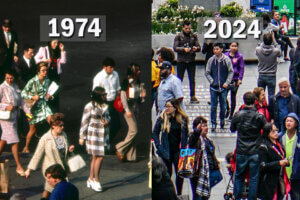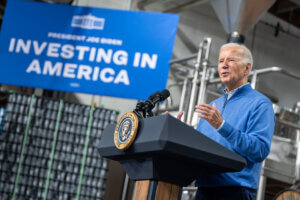West Long Branch, NJ – Are American voters looking for a presidential candidate who adheres to a particular ideology or are they more interested in finding someone with a specific political pedigree? Or is it a mixture of these two dimensions? The Monmouth University Poll conducted a test of five different qualities the American electorate may look for in a presidential candidate and found that voters prioritize different frames to assess their choices. For some it is conservative, progressive or moderate issue positions that matter most while others prioritize political experience or being a political outsider over any ideological stance.
The poll presented five qualities in ten pairings and asked voters which matters more to them in choosing a presidential candidate. In a direct matchup between two résumé-related qualities, voters prefer a presidential candidate with political experience (56%) over one who is a political outsider (35%). When comparing different positions on the political ideology spectrum, a candidate with moderate issue positions is preferred to one with either conservative (59% to 36%) or progressive (60% to 33%) views by most voters. When a moderate ideological stance is pitted against political experience, voters are almost evenly divided between prioritizing moderate issue positions (48%) or political experience (43%) as the more important quality when choosing a presidential candidate.
Political experience outpolls both conservative (55% to 40%) and progressive (52% to 36%) issue positions as the quality voters value more. Moderate issue positions (59%) are preferred to being a political outsider (32%) for most voters. Other choices posed by the poll show a nearly even split in voter preference for a political outsider (46%) versus conservative positions (43%) and a political outsider (44%) versus progressive positions (46%), as well as for conservative (47%) versus progressive (45%) issue positions.
Responses to the ten forced-choice pairings were used to build a typology* of presidential candidate quality priorities along both dimensions – political résumé and ideological stance. Overall, half of the American electorate can be classified as ideological voters, preferring a specific issue position over any other quality. However, these voters’ priorities are nearly evenly divided among conservative (18%), progressive (15%), and moderate (17%) views. Just over 1 in 4 voters look at a candidate’s background over any specific set of issue stances, with 18% preferring someone with political experience and 9% preferring a political outsider. Another 22% of American voters, though, do not express a singular preference for any one of the five candidate characteristics polled and are much harder to classify when these two dimensions are considered jointly.
“We have a tendency to talk about the vote choice along just one dimension. Yes, many voters value ideology over other considerations, but quite a few are looking primarily at political pedigree to make their decision. And still others give equal weight to both dimensions. We really need to take this complexity into account before we try to slot voters and candidates into one-dimensional lanes,” said Patrick Murray, director of the independent Monmouth University Polling Institute.
The Monmouth University Poll finds strong relationships between voter quality preferences and political identity. A majority of self-identified Republicans and Republican-leaning voters stake out an ideological position in choosing a presidential candidate, with 36% classified as prioritizing conservative issue positions over all other qualities, 13% prioritizing a candidate with moderate positions and 4% prioritizing a progressive candidate. About 1 in 5 Republicans and Republican-leaning voters look primarily at a candidate’s résumé rather than ideology, with those who prefer a political outsider (18%) outnumbering those who prioritize political experience (4%) in their vote decision. Another 25% of Republican voters do not have a prevailing priority when all five qualities are considered simultaneously.
A majority of voters who self-identify as Democrats and Democratic leaners are likely to be ideology-first voters, with 30% classified as prioritizing progressive issue positions, 21% moderate positions, and just 2% conservative positions. However, a sizable number of Democratic voters (28%) prioritize political experience over any ideological position, while just 2% prioritize being a political outsider as their top candidate value. Another 17% of Democrats are mixed in their candidate quality priorities.
Among pure independent voters who do not lean toward either party, just over a third are ideological voters (20% moderate, 12% conservative, and 5% progressive), while 26% value political experience over all the other qualities polled and 5% value being a political outsider. Nearly 1 in 3 independents (32%) cannot be pinned down as prioritizing any single quality on these two dimensions.
“Some voters choose the candidate’s political background as the highest priority in their ballot decision, but experience voters end up aligning with Democrats while outsider voters fall into the Republican camp. This is probably a byproduct of who sits in the Oval Office right now,” said Murray.
| PRESIDENTIAL CANDIDATE QUALITY PRIORITY VOTER TYPOLOGY | ||||||||
| Résumé | Ideology | |||||||
| Outsider | Experience | Conservative | Progressive | Moderate | Mixed | |||
| All voters | 9% | 18% | 18% | 15% | 17% | 22% | ||
| Republicans + leaners | 18% | 4% | 36% | 4% | 13% | 25% | ||
| Democrats + leaners | 2% | 28% | 2% | 30% | 21% | 17% | ||
| Pure independents | 5% | 26% | 12% | 5% | 20% | 32% | ||
| White men, no college degree | 13% | 6% | 29% | 11% | 13% | 27% | ||
| White women, no college degree | 6% | 19% | 18% | 16% | 16% | 26% | ||
| White men, college graduates | 14% | 15% | 21% | 13% | 17% | 19% | ||
| White women, college graduates | 4% | 16% | 15% | 18% | 30% | 17% | ||
| Men of color | 8% | 25% | 20% | 15% | 12% | 19% | ||
| Women of color | 9% | 29% | 4% | 24% | 21% | 14% | ||
Another way to look at these voter types is by examining the self-described political affiliations of each group. Two groups primarily identify themselves as Republican or Republican-leaning voters – the conservative priority group (86%) and the outsider group (84%) – while two others are primarily made up of Democrats and Democratic leaners – the progressive priority group (84%) and the experience group (70%). Voters who prioritize moderate issue positions in a presidential candidate are more likely to align with or lean toward Democrats (52%) than Republicans (32%), while 15% see themselves as pure independents. Mixed dimension voters include Republicans (48%), Democrats (33%) and pure independents (19%).
Progressive voters are the youngest voting bloc (51% under 35 years old), while the conservative (13%) and outsider (12%) groups are the least likely to include younger voters. The most racially diverse group are those who prioritize political experience (49% people of color), followed by the progressive issue group (40%). Voters in both the progressive (43%) and moderate (43%) groups are more likely than others to have graduated college. Just over 6 in 10 voters in the conservative (65%) and outsider (63%) groups are men, while women dominate the progressive (61%), moderate (62%), and experience (60%) groups. Voters in the mixed typology group with no single quality preference are more evenly balanced by gender (53% men and 47% women).
“It is important to note that this poll looked at only two dimensions along which voters make their candidate choice. There are certainly other factors which should be examined, but these results offer a counterpoint to narratives that try to lump American voters into one-dimensional ideological lanes,” said Murray.
Nearly all outsider voters (92%) and conservative voters (87%) support President Donald Trump’s reelection, while the vast majority of experience voters (84%) and progressive voters (90%) want someone new. Moderate voters are also likely to want a different president (75%). Those in the mixed preference group are evenly divided on their 2020 vote (50% would reelect Trump and 47% want someone new).
This two-dimensional quality priority typology also helps to classify voters in the Democratic nomination contest, but it does not fully explain individual candidate choice. Among Democrats and Democratic-leaning voters nationwide, those who prioritize experience over the other four qualities polled tend to back Joe Biden (44%) more than any other candidate in the field, including Elizabeth Warren (14%), Bernie Sanders (12%), Pete Buttigieg (6%), Amy Klobuchar (4%), and Mike Bloomberg (4%). Among progressive priority voters, 43% support Sanders and 25% back Warren, with 9% for Biden and 7% for Buttigieg. Among moderate priority voters, 23% support Biden, 14% Buttigieg, 11% Sanders, 11% Bloomberg, 9% Warren, and 7% Klobuchar. Among the remaining Democrats, including those who cannot be assigned to a specific quality preference as well as a handful of outsider and conservative voters, 28% support Biden, 16% Warren, 10% Sanders, 8% Buttigieg, 5% Klobuchar, and 5% Bloomberg.
“Even when we analyze voters on two dimensions rather than just one, it is really difficult to pin them down into a single lane. The American electorate is a little more complex than we like to give it credit for,” said Murray.
The Monmouth University Poll was conducted by telephone from December 4 to 8, 2019 with 903 adults in the United States. The results in this release are based on 838 registered voters and have a +/- 3.4 percentage point sampling margin of error. The poll was conducted by the Monmouth University Polling Institute in West Long Branch, NJ.
* The presidential candidate quality priority typology was created by first counting the number of times a specific quality was chosen when pitted against each other quality in a forced-choice pairing, with the potential values ranging from “0” (quality was never chosen as the higher priority) to “4” (quality was chosen as the higher priority in every pairing). Voters were then classified as preferring a specific type of quality if it was chosen more often than the other four qualities in at least three of the matchups. The vast majority of those assigned to a specific quality chose it as their preference in all four pairings (i.e. 92% of outsider voters chose the political outsider against each of the other four qualities, experience was 98%, conservative 97%, progressive 95%, and moderate 94%). The remaining voters assigned to a specific quality preferred that quality in three pairings while opting not to make a choice either way in the remaining matchup involving that quality.
QUESTIONS AND RESULTS
(* Some columns may not add to 100% due to rounding.)
[Q1-12 previously released.]
13. Voters look at many different qualities when choosing a presidential candidate to support. For each of the following pairs of qualities I read, please tell me which one is more important to you if you had to choose.[ITEMS WERE ROTATED] [CHOICES WERE ROTATED]
Someone who is a political outsider or someone with political experience
| Dec. 2019 | |
| Political outsider | 35% |
| Political experience | 56% |
| (VOL) Don’t know | 9% |
| (n) | (838) |
Someone with conservative issue positions or someone with moderate issue positions
| Dec. 2019 | |
| Conservative issue positions | 36% |
| Moderate issue positions | 59% |
| (VOL) Don’t know | 5% |
| (n) | (838) |
Someone with progressive issue positions or someone with moderate issue positions
| Dec. 2019 | |
| Progressive issue positions | 33% |
| Moderate issue positions | 60% |
| (VOL) Don’t know | 7% |
| (n) | (838) |
Someone who is a political outsider or someone with conservative issue positions
| Dec. 2019 | |
| Political outsider | 46% |
| Conservative issue positions | 43% |
| (VOL) Don’t know | 11% |
| (n) | (838) |
Someone who is a political outsider or someone with progressive issue positions
| Dec. 2019 | |
| Political outsider | 44% |
| Progressive issue positions | 46% |
| (VOL) Don’t know | 10% |
| (n) | (838) |
Someone who is a political outsider or someone with moderate issue positions
| Dec. 2019 | |
| Political outsider | 32% |
| Moderate issue positions | 59% |
| (VOL) Don’t know | 9% |
| (n) | (838) |
Someone with political experience or someone with conservative issue positions
| Dec. 2019 | |
| Political experience | 55% |
| Conservative issue positions | 40% |
| (VOL) Don’t know | 6% |
| (n) | (838) |
Someone with political experience or someone with progressive issue positions
| Dec. 2019 | |
| Political experience | 52% |
| Progressive issue positions | 36% |
| (VOL) Don’t know | 12% |
| (n) | (838) |
Someone with political experience or someone with moderate issue positions
| Dec. 2019 | |
| Political experience | 43% |
| Moderate issue positions | 48% |
| (VOL) Don’t know | 9% |
| (n) | (838) |
Someone with conservative issue positions or someone with progressive issue positions
| Dec. 2019 | |
| Conservative issue positions | 47% |
| Progressive issue positions | 45% |
| (VOL) Don’t know | 8% |
| (n) | (838) |
[Q14-26 previously released.]
METHODOLOGY
The Monmouth University Poll was sponsored and conducted by the Monmouth University Polling Institute from December 4 to 8, 2019 with a national random sample of 903 adults age 18 and older, in English. This includes 363 contacted by a live interviewer on a landline telephone and 540 contacted by a live interviewer on a cell phone. The results in this poll release are based on a subsample of 838 registered voters. Telephone numbers were selected through random digit dialing and landline respondents were selected with a modified Troldahl-Carter youngest adult household screen. Monmouth is responsible for all aspects of the survey design, data weighting and analysis. The full sample is weighted for region, age, education, gender and race based on US Census information (CPS 2018 supplement). Data collection support provided by Braun Research (field) and Dynata (RDD sample). For results based on the registered voter sample, one can say with 95% confidence that the error attributable to sampling has a maximum margin of plus or minus 3.4 percentage points (unadjusted for sample design). Sampling error can be larger for sub-groups (see table below). In addition to sampling error, one should bear in mind that question wording and practical difficulties in conducting surveys can introduce error or bias into the findings of opinion polls.
| DEMOGRAPHICS (weighted) |
| REGISTERED VOTERS |
| 27% Republican |
| 42% Independent |
| 31% Democrat |
| 49% Male |
| 51% Female |
| 28% 18-34 |
| 34% 35-54 |
| 38% 55+ |
| 67% White |
| 12% Black |
| 15% Hispanic |
| 6% Asian/Other |
| 68% No degree |
| 32% 4 year degree |
Click on pdf file link below for full methodology and results by key demographic groups.




